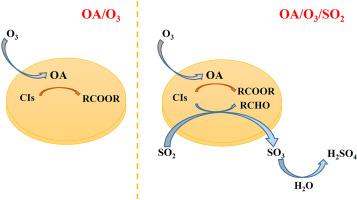当前位置:
X-MOL 学术
›
Atmos. Environ.
›
论文详情
Our official English website, www.x-mol.net, welcomes your
feedback! (Note: you will need to create a separate account there.)
The influence of SO2 as the Criegee intermediate scavenger on the heterogeneous oxidation of oleic acid
Atmospheric Environment ( IF 4.2 ) Pub Date : 2020-06-01 , DOI: 10.1016/j.atmosenv.2020.117560 Miao Yang , Shuai-Shuai Ma , Hamad Ashraf , Shu-Feng Pang , Yun-Hong Zhang
Atmospheric Environment ( IF 4.2 ) Pub Date : 2020-06-01 , DOI: 10.1016/j.atmosenv.2020.117560 Miao Yang , Shuai-Shuai Ma , Hamad Ashraf , Shu-Feng Pang , Yun-Hong Zhang

|
Abstract As a well-known Criegee intermediate (CI) scavenger, SO2 can react with CIs in the gas phase to form sulphuric acid, which can be further converted to sulfate aerosols, which make an important contribution to haze formation. Despite the potential importance, the interaction of SO2 with the CIs produced by heterogeneous oxidation of unsaturated fatty acids remains largely unclear. In this work, the heterogeneous reactions of oleic acid (OA) thin films with O3 and O3/SO2 mixture gases are studied under four different relative humidities (RHs): 5%, 30%, 60% and 80%, using microscopic Fourier transform infrared (micro-FTIR) spectrometer combined with a gas-flow system. A detailed comparison on formation rates of ester and intensity ratios of 1742 cm−1 band (envelope C O of ester) to 1712 cm−1 band (feature C O of carboxyl) between the two reaction systems shows that the addition of SO2 inhibits the conversion of carboxyl to ester at any RH. As the SO2 concentration increases, the formation rates and final relative amount of ester decrease. Based on these data, it can be concluded that SO2 consumes part condensed-phase CIs produced by ozonolysis of OA, resulting in a significant inhibition in ester formation. The present results provide an important atmospheric implication on the reaction between SO2 and condensed-phase CIs, which may be a missing sulfate production pathway in the atmosphere.
中文翻译:

SO2作为Criegee中间清除剂对油酸异相氧化的影响
摘要 作为著名的 Criegee 中间体 (CI) 清除剂,SO2 可以在气相中与 CIs 反应生成硫酸,硫酸可以进一步转化为硫酸盐气溶胶,这对雾霾的形成做出了重要贡献。尽管具有潜在的重要性,但 SO2 与不饱和脂肪酸异相氧化产生的 CI 之间的相互作用仍不清楚。在这项工作中,油酸 (OA) 薄膜与 O3 和 O3/SO2 混合气体的多相反应在四种不同的相对湿度 (RH) 下进行了研究:5%、30%、60% 和 80%,使用微观傅立叶变换红外(微 FTIR)光谱仪与气流系统相结合。两种反应体系之间酯的形成速率和 1742 cm-1 带(酯的包络 CO)与 1712 cm-1 带(羧基的特征 CO)的强度比的详细比较表明,SO2 的加入抑制了在任何RH下羧基酯化。随着 SO2 浓度的增加,酯的形成速率和最终相对量减少。基于这些数据,可以得出结论,SO2 消耗了部分由 OA 臭氧分解产生的冷凝相 CI,从而显着抑制了酯的形成。目前的结果为 SO2 和凝相 CI 之间的反应提供了重要的大气影响,这可能是大气中缺少的硫酸盐生产途径。随着 SO2 浓度的增加,酯的形成速率和最终相对量减少。基于这些数据,可以得出结论,SO2 消耗了部分由 OA 臭氧分解产生的冷凝相 CI,从而显着抑制了酯的形成。目前的结果为 SO2 和凝相 CI 之间的反应提供了重要的大气影响,这可能是大气中缺少的硫酸盐生产途径。随着 SO2 浓度的增加,酯的形成速率和最终相对量减少。基于这些数据,可以得出结论,SO2 消耗了部分由 OA 臭氧分解产生的冷凝相 CI,从而显着抑制了酯的形成。目前的结果为 SO2 和凝相 CI 之间的反应提供了重要的大气影响,这可能是大气中缺少的硫酸盐生产途径。
更新日期:2020-06-01
中文翻译:

SO2作为Criegee中间清除剂对油酸异相氧化的影响
摘要 作为著名的 Criegee 中间体 (CI) 清除剂,SO2 可以在气相中与 CIs 反应生成硫酸,硫酸可以进一步转化为硫酸盐气溶胶,这对雾霾的形成做出了重要贡献。尽管具有潜在的重要性,但 SO2 与不饱和脂肪酸异相氧化产生的 CI 之间的相互作用仍不清楚。在这项工作中,油酸 (OA) 薄膜与 O3 和 O3/SO2 混合气体的多相反应在四种不同的相对湿度 (RH) 下进行了研究:5%、30%、60% 和 80%,使用微观傅立叶变换红外(微 FTIR)光谱仪与气流系统相结合。两种反应体系之间酯的形成速率和 1742 cm-1 带(酯的包络 CO)与 1712 cm-1 带(羧基的特征 CO)的强度比的详细比较表明,SO2 的加入抑制了在任何RH下羧基酯化。随着 SO2 浓度的增加,酯的形成速率和最终相对量减少。基于这些数据,可以得出结论,SO2 消耗了部分由 OA 臭氧分解产生的冷凝相 CI,从而显着抑制了酯的形成。目前的结果为 SO2 和凝相 CI 之间的反应提供了重要的大气影响,这可能是大气中缺少的硫酸盐生产途径。随着 SO2 浓度的增加,酯的形成速率和最终相对量减少。基于这些数据,可以得出结论,SO2 消耗了部分由 OA 臭氧分解产生的冷凝相 CI,从而显着抑制了酯的形成。目前的结果为 SO2 和凝相 CI 之间的反应提供了重要的大气影响,这可能是大气中缺少的硫酸盐生产途径。随着 SO2 浓度的增加,酯的形成速率和最终相对量减少。基于这些数据,可以得出结论,SO2 消耗了部分由 OA 臭氧分解产生的冷凝相 CI,从而显着抑制了酯的形成。目前的结果为 SO2 和凝相 CI 之间的反应提供了重要的大气影响,这可能是大气中缺少的硫酸盐生产途径。





















































 京公网安备 11010802027423号
京公网安备 11010802027423号